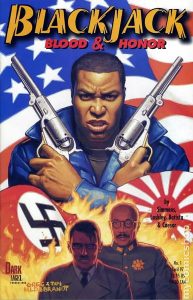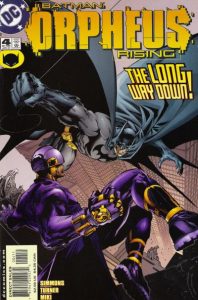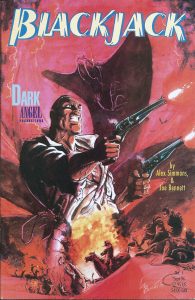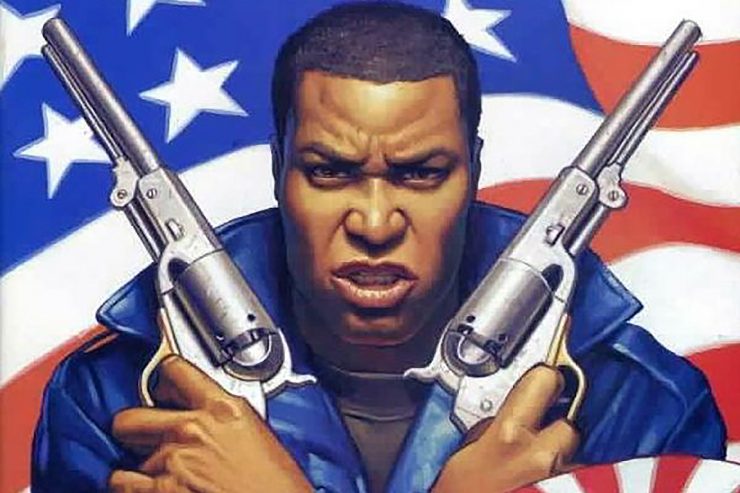Pulp magazines have influenced writers, artists, film directors, software developers, and countless others over the years. Our “PulpFest Profiles” focus on contemporary creators who have drawn inspiration from these rough-paper fiction magazines.
 Alex Simmons stood by his translator at the 2017 KomMissia Comics Festival in Moscow, the lone American representative amid international artists, writers and publishers invited to meet with Russian creatives. The writer of hundreds of thrilling tales was there for the opening of a month-long art exhibit featuring enormous blow-up prints of the many American characters he’s written, including Tarzan, Batman, Archie, and Scooby-Doo. Most prominent among them was Simmons’ own creation, Arron “Blackjack” Day. The 1930’s African-American soldier of fortune has starred in comics, audio, and modern pulp novels and has earned a cult following over more than a quarter-century of blasting through adventures around the globe.
Alex Simmons stood by his translator at the 2017 KomMissia Comics Festival in Moscow, the lone American representative amid international artists, writers and publishers invited to meet with Russian creatives. The writer of hundreds of thrilling tales was there for the opening of a month-long art exhibit featuring enormous blow-up prints of the many American characters he’s written, including Tarzan, Batman, Archie, and Scooby-Doo. Most prominent among them was Simmons’ own creation, Arron “Blackjack” Day. The 1930’s African-American soldier of fortune has starred in comics, audio, and modern pulp novels and has earned a cult following over more than a quarter-century of blasting through adventures around the globe.
Simmons has done the same even longer. He’s represented his craft in Russia, Serbia, the Netherlands, India, Mexico, Senegal, Kenya, Nigeria, Congo, and throughout the USA. And like Blackjack, he’s rolled with each situation no matter how exotic the locale.
In Russia, he was to teach classes on surviving as an independent writer and participate on a panel about the creation, publication, and distribution of adventure tales, both of which he’s done around the world for years. But when the Russian host uttered three words the writer didn’t need to be translated — “American Alex Simmons” — another adventure began.
“He is introducing you,” his translator said. “It is time for you to address the convention.”
Suddenly Simmons was expected to represent himself, the publishing industry, and his country to a crowd loaded with expectations for “the American.”
No problem. He’d been studying impossible situations his entire life, starting as a young boy in a small apartment in lower Manhattan, sick in bed, listening to a radio show that started with the exhilarating gallop of Rossini’s “William Tell Overture.” That day the Lone Ranger and Tonto helped pull young Alex through. And they never really left him.
Simmons’ childhood was filled with adventure stories. He clearly remembers a Sunday night when he was about nine, sitting on the floor near his mother’s chair, listening to a radio episode of GUNSMOKE. The sounds and voices excited his imagination. He wanted more.
 A few years later, in 1966, he and his friends talked for weeks about an upcoming TV show that was going to be the greatest thing ever – BATMAN. “We were so pumped! But when I saw the first episode, it came off as comical. It wasn’t what we were looking for,” he says. “When Green Hornet showed up, we took that seriously. It had danger, great fight scenes. No ‘Kapow!’ That was closer to the comic book action we were thrilled about.”
A few years later, in 1966, he and his friends talked for weeks about an upcoming TV show that was going to be the greatest thing ever – BATMAN. “We were so pumped! But when I saw the first episode, it came off as comical. It wasn’t what we were looking for,” he says. “When Green Hornet showed up, we took that seriously. It had danger, great fight scenes. No ‘Kapow!’ That was closer to the comic book action we were thrilled about.”
Between those two premieres, the future award-winning author started finding out more about old radio shows. Simmons got his hands on two LPs, THE LONE RANGER and THE GREEN HORNET. Each included two episodes. He played the grooves off both. “That was the first time I remember hearing the Green Hornet in action. We listened to those stories over and over,” he remembers. “You have to understand, for my generation at least, we were used to seeing our heroes in comic books. So, hearing this was even cooler: the music, the sound effects, Kato talking — all of this was ridiculously exciting, so you replayed that sucker like crazy.”
Simmons plunged further into the rich roots of American adventure tales when he discovered the Doc Savage pulps reprinted as Bantam paperbacks. Doc was the paragon of virtue, but he led Simmons to another kind of hero who existed in a darker, more dangerous world — The Shadow. He was hooked.
“Now I’m totally over the moon, gobbling those things up like candy. Jim Steranko was doing covers for the paperback reprints of the old pulps. He really drew you in . . . and made you want to read.”
Simmons eventually favored The Shadow over The Man of Bronze. “Doc had more ethics. Doc was fair, he shot tranquilizer bullets,” Simmons says. “The Shadow didn’t. He was righteous. Doc would take you down. The Shadow would take you out. Doc was concerned with justice. The Shadow was about revenge. Yet he was more. He was mysterious, a master of disguise. He was brilliant, thinking, and plotting and planning. He didn’t just kick doors in and hurt people; he knew exactly who had committed atrocious crimes.”
Any reader of Blackjack can see a fascinating mix of Doc Savage and the Shadow in Arron Day’s DNA. He is a fair-minded world adventurer like Doc, but once a moral line is crossed, the Blackjack side of him emerges and death follows a la The Shadow.
 Blackjack also tends to ride off into the sunset like the Lone Ranger and is willing to buck perceptions like the Green Hornet. And Simmons sees how the pulps and old radio shows influenced how Blackjack leaps into adventures with a carefully selected, diverse core of associates, as Simmons has done all his life, no matter where it led him.
Blackjack also tends to ride off into the sunset like the Lone Ranger and is willing to buck perceptions like the Green Hornet. And Simmons sees how the pulps and old radio shows influenced how Blackjack leaps into adventures with a carefully selected, diverse core of associates, as Simmons has done all his life, no matter where it led him.
While attending the High School of Art and Design in New York City, Simmons and a friend, Tom Doran, bound by their love of pulps, decided it was a good idea to venture down a seedy alley, through a sketchy door, and into a dark basement full of men they didn’t know. “We figured we were young and could run, we’d be all right,” Simmons says. “And we found what we were looking for, a pulp serials film club.”
Turns out the men met there to binge-watch entire multi-episode arcs of CAPTAIN MARVEL, SPY SMASHER, THE SHADOW, THE MASKED MARVEL, CAPTAIN AMERICA, KING OF THE ROCKET MEN, SUPERMAN, and THE GREEN HORNET, among others. Soon watching wasn’t enough.
“One day Tom says to me, ‘We can do this,’ and we went ahead and created our own.” The serial, created, filmed, and starring them, concerned an ex-patriot and a reporter seeking to quell an uprising of bandits in the Middle East, all filmed around the castle in Central Park, and another location. “I somehow talked someone into letting us use an old brownstone that was a historic landmark,” Simmons reports with a chuckle. “We shot a ballroom scene in there, entirely with 15 to 17-year-olds.” Even 50 years later, Simmons has never seen the completed film.
Soon after he met writer Don McGregor at a comic con. They kept in touch via phone calls, letters, and visits to Rhode Island, where McGregor announced to Simmons, “I’ve got an idea. I’ll write, you draw.” And thus DETECTIVES, INC. was created in 1969-1970.
“I finished the last page and we Xeroxed and stapled thirty to forty copies, each with this fuchsia stock cover, and took them to Phil Seuling’s Comic Convention in New York City. We sold a bunch.”
McGregor would eventually reboot DETECTIVES, INC. with artist Marshall Rogers for Eclipse, but not before he and Simmons took it on one more escapade. “I’d visit Rhode Island and we would film scenes with other actors, swinging axes, rolling down hills. We were crazy,” Simmons says.
McGregor eventually wrote a proper script, got backing, brought in staff and actors, and shot for over a year on weekends in multiple New York City and Long Island locations. The film — starring Alex, Richard Douglass, and Marsha McGregor as the characters from the graphic novel — had its premiere at a James Bond convention in 1984 or 1985.
Simmons kept having adventures and writing everything from comics to biographies to children’s books to an international Sunday Strip featuring Edgar Rice Burroughs’ Tarzan. His first Sunday strip was drawn by Grey Morrow, while another story has Simmons’ Blackjack meeting the Lord of the Jungle.
“I have to give a shout out to Amy Lago (then an editor at United Features Syndication), who pitched the idea. When I realized she was serious I said, ‘Well, they live in different eras but I’ll see what I can do.’” He sure did.

After decades of publishing fiction and non-fiction, comics, short stories, and novels, all of Simmons’ experiences culminated in Arron “Blackjack” Day, for whom he’s received a number of awards. His hard-traveling soldier-of-fortune is the sum of all the pulp, comics, radio, and movie heroes he’s loved.
Simmons brings other influences, too, most prominently, the black experience in America and how the contributions and heroics of people of color have often gone unheralded: “We can’t forget what happened, we shouldn’t, not as a way to hold onto the bile but as a way to recognize the disease and to cure it, or at least keep it at bay, diminish its impact on us. For me, it’s about celebrating the accomplishments in the face of the limiting beliefs that would hold us back. For people of color to truly obtain and maintain our rightful place in this world, we have to stop letting the successes of our history vanish and be forgotten. So I have chosen a fun, entertaining way of pointing it out, of calling it out.”
Blackjack is set in the pulp era, according to Simmons, because, “It is the era when heroes were clearer. We need that clarity today because we, as human beings, find it very convenient to forget the past. And I think it is one of the reasons we keep screwing up generation after generation. We need to grow more tolerant of everybody’s differences and stop getting in the way of people making their way in this life. So, I think we do need Blackjack, who says, ‘Despite the crap you throw at me, I’m going to keep coming. Even though you think I’m less than you, you need me. Despite the fact that you have called me this name and that name, I have saved your life.’”
Simmons can point to Blackjacks throughout today’s society. “There are folks in hospitals right now who would call somebody from Pakistan or Harlem or China a dirty name and their life depends on that aide, that nurse, or that doctor who is busting his or her ass to save yours. Arron Day needs to be where he is to remind us that men and women of those times fought for a country that didn’t appreciate them. Died for a country that did not give them the freedom they had already earned. Blackjack is needed now because many folks are still comfortable with their ignorance. Maybe they don’t see themselves as racists but folks, it ain’t working for everybody else. So Blackjack is needed now more than ever.”
It is that kind of heart that informed Simmons’ words to that international audience in Russia when he suddenly had to speak to the world. He stood before them and simply said, “I cannot represent everything you expect an American to be. I can only be me.”
What a perfect response. In it dwells all the great American independence we see in every pulp hero that influenced who he is, and who we are.
To learn more about Alex Simmons and his work, please visit simmonshereandnow.com.
Christopher Ryan has been an award-winning journalist, teacher, podcaster, actor, producer, and director, but mostly he writes fast-paced stories with humor and heart. You can learn more about Christopher and his work at www.chrisryanwrites.
Alex and Christopher have been friends and worked together for over thirty years. Their podcast, TELL THE DAMN STORY, has been airing since 2018. You can tune in on Apple Podcasts, Pocket Cast, Spotify, or other podcast platforms.
BLACKJACK: BLOOD & HONOR was a four-issue miniseries written by Alex Simmons and released by Dark Angel Productions in 1997. The cover art for the first issue was by Tim and Greg Hildebrandt. The interior artists for the series included Chris Batista, Caesar, Grey, Jamal Igle, and Ken Lashley.
BATMAN: ORPHEUS RISING was a five-issue miniseries written by Alex Simmons, with art by Dwayne Turner and Danny Miki. It was released in 2001 by DC Comics.
BLACKJACK: SECOND BITE OF THE COBRA was a three-issue miniseries written by Alex Simmons and released by Dark Angel Productions in 1996. The cover art for the first issue was by Joe Bennett, the artist for the series.
In 2002, following the suggestion of Amy Lago, his editor at United Features Syndication, Alex teamed his soldier of fortune, Arron “Blackjack” Day, up with Edgar Rice Burroughs’ Tarzan of the Apes in a comic strip drawn by Eric Battle.
PulpFest would like to thank Buddy Saunders and mycomicshop.com for their tremendous help with our images.






